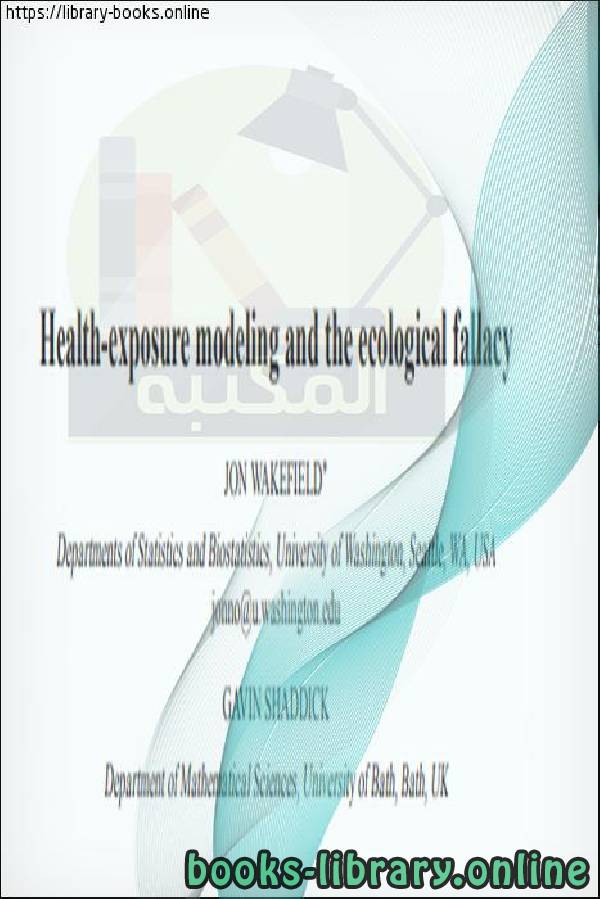📘 قراءة كتاب exposure modeling and the ecological fallacy أونلاين


Biologically
Biology is a natural science that is concerned with the study of life, its various forms and its function, how these organisms interact with each other and with the surrounding environment. The word biology in Greek is made up of two words: bio (βίος) meaning life. And loggia (-λογία) means science or study. Biology: the similarity of vegetation and animal cover on the edges of the African and American states, and the existence of the same fossil.
Branches of biology
Biology is an ancient science thousands of years old and modern biology began in the nineteenth century. This science has multiple branches. Among them are:
Anatomy
Botany
Biochemia
Biogeography
Biofisia
Cytology or cell science
Ecology or environmental science
نبذه عن الكتاب:
practice since regression estimates can be sensitive to the particular spatial model used. The model may
provide more appropriate standard errors than under an assumption of independent outcomes, however.
If there is evidence of residual spatial dependence, then we would recommend carrying out sensitivity
analyses under a range of scenarios, including models that do and do not acknowledge spatial dependence.
Model (3.2), with some modification, also allows computation for the disease-mapping model of
Kelsall and Wakefield (2002) to be carried out without recourse to approximation. For a related approach,
see Follestad and Rue (2003).
A difficult yet crucial issue in any analysis that uses spatially referenced exposure data is whether to
model the exposure surface. As an aid to making this decision, we would recommend following the procedure described in Section 4. Specifically, one may fit a model to the monitor exposure data, and simulate
new monitor and population location exposure data using the fitted model; the differences between known
and estimated values can then be examined, to gain insight into whether an exposure modeling strategy is
likely to be successful. The study design will often inform the need to model the exposure surface.
An interesting design question is the determination of which populations to study in relation to the location of the pollution monitors. This choice represents the classic mean–variance trade-off; populations
close to a monitor have accurate exposure assessment but are small in size, while examining larger populations gives an increase in power but results in less accurate exposure estimates. One way of increasing
power is to have a dense monitoring network, where dense is relative to both the spatial variability in
exposure and the population distribution. If the exposure surface is relatively flat, only a sparse network is
required, but in this case a spatial study will have low power due to narrow exposure contrasts. In studies
of the acute effects of air pollution, temporal contrasts provide the greatest exposure information, which
suggests that in such a study, modeling spatial variability in exposure will not be worthwhile.
Biology
Human biology
Who is the founder of biology?
The importance of biology
Areas of work in the field of biology
Theories of biology
Research on biology for the first grade of secondary school
Human biology
سنة النشر : 2006م / 1427هـ .
حجم الكتاب عند التحميل : 302 .
نوع الكتاب : pdf.
عداد القراءة:
اذا اعجبك الكتاب فضلاً اضغط على أعجبني و يمكنك تحميله من هنا:

شكرًا لمساهمتكم
شكراً لمساهمتكم معنا في الإرتقاء بمستوى المكتبة ، يمكنكم االتبليغ عن اخطاء او سوء اختيار للكتب وتصنيفها ومحتواها ، أو كتاب يُمنع نشره ، او محمي بحقوق طبع ونشر ، فضلاً قم بالتبليغ عن الكتاب المُخالف:
 قبل تحميل الكتاب ..
قبل تحميل الكتاب ..
يجب ان يتوفر لديكم برنامج تشغيل وقراءة ملفات pdf
يمكن تحميلة من هنا 'http://get.adobe.com/reader/'


 منصّة المكتبة
منصّة المكتبة 